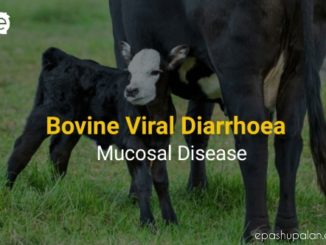Abstract: Porcine reproductive and respiratory syndrome (PRRS) virus is considered to be one of the most costly diseases affecting intensive pig production worldwide. PRRS is recognized as an economically important swine disease worldwide. India has reported the first outbreak of PRRS in pig population of Mizoram state to OIE (World Organization for Animal Health) on 26th June, 2013. The disease was observed to affect all age groups including the pregnant sows with morbidity rate 44.01% – 80.29% and mortality rate 14.51% – 66.11%. Severe pathological lesions like hemorrhagic interstitial pneumonia, hemorrhagic lymphadenitis with lymphoid depletion, vasculitis and interstitial nephritis were observed in pigs of all age groups and reproductive failure in pregnant sows. Diagnosis of the disease was confirmed by RT-PCR on tissue samples targeting the ORF-4 and ORF-7 genes of PRRS virus. Control of PRRS is a complex issue and involves a combination of measures including monitoring, diagnosis, biosecurity, herd management, and immunization.

Keywords: PRRS, pathology, control, diagnosis, India.
Definition: PRRS is an acronym (porcine reproductive and respiratory syndrome) for a viral disease characterized by two overlapping clinical presentations, reproductive impairment or failure in breeding animals, and respiratory disease in pigs of any age.
Synonyms: It was referred to as Mystery Swine Disease, Blue-Eared Pig Disease, Swine Mystery Disease (SMD) or Swine Infertility and Respiratory Syndrome (SIRS) before Porcine Reproductive and Respiratory Syndrome (PRRS) became the generally agreed-upon time.
Susceptible Species
- The pig (Sus scrofa), whether domestic or feral, is the only species known to be naturally susceptible to this disease. Other species of wild pig and members of family Suidae may be susceptible.
Historical Information
- PRRS virus disease was first recognized in the USA in 1987 and in Europe in 1990.
- The epidemiology and genetic diversity of PRRS virus is constantly changing. In recent past the pig industries of three neighbouring countries of India, namely China, Myanmar and Bhutan were severely affected by outbreaks of highly pathogenic-PRRS.
- In India, the first PRRS virus outbreak in the pig population of Mizoram in 2013 and second outbreak done again in year 2015 in Mizoram.
Occurrence
- PRRS occurs in all age groups.
- Reproductive impairment or failure, more obvious in sows or gilts, also affects some boars.
- The respiratory syndrome is seen more often in young growing pigs but also occurs in naïve finishing pigs and breeding stock.
Etiology
- The PRRS virus is an enveloped RNA virus genus Arterivirus, classified in the virus family, Arteriviridae.
- The virus is easily inactivated by phenol, formaldehyde, and most common disinfectants.
- RNA virus that is quickly inactivated by lipid solvents, heat, drying, or at a pH below 5 or above 7 (Benfield et al., 1992).
- Complete inactivation of the virus is accomplished in 1 minute using iodine (0.0075%) or quarternary ammonium compounds (0.0063%). Similarly, 10 minute of ultraviolet light exposure completely inactivated the virus on common farm surfaces and materials (Shirai et al., 2000).
Transmission
- Direct contact or indirectly through fomites.
- Aerial transmission (either short or long distance).
- Coitus or insemination.
- Ingestion by contact.
- Intraocular (most often iatrogenically).
- Vertical transmission is important during the last trimester of gestation.
Pathogenesis
Once transmission of virus to the tonsil or upper respiratory system has occurred, primary replication occurs in lymphoid tissues.
![]()
Viraemia follows and may persist for several weeks. The virus has a predilection for lymphoid tissues (Spleen, Thymus, Tonsils, Lymph Nodes, Peyer’s Patches). It infects and compromises the function of pulmonary alveolar and intravascular macrophages resulting in interstitial pneumonia. PRRS appears to increase susceptibility of the lungs to other pathogens.
![]()
PRRS virus is known to cross the placenta in late gestation (after the 72nd day) and may reach a high titer in fetuses. It may kill all, part or none of the fetuses. It is suggested that fetuses are killed by hypoxia that occurs as a result of the arteries that may develop in umbilical vessels.
![]()
Abortions are common, the result of either the effects of acute disease and fever in sows or infection and death of fetuses.
![]()
Recovered sows are resistant to re-infection when exposed to a homologous strain of the virus but are likely to show clinical signs if a heterologous strain is encountered.
Clinical Signs
- PRRSV is probably the most important swine disease of the last half-century. Where signs are apparent, they vary and are influenced by
1) virulence of the virus,
2) whether it is an initial infection or ongoing (endemic with herd immunity),
3) the age group affected,
4) other disease causing agents present in the population, and
5) herd size and management practices.
|
In adults |
In affected litters |
In weaned pigs |
| Reduced appetite | Stillborn pigs | Loss of appetite and lethargy |
| Fever | High pre-weaning mortality | Obvious failure to thrive |
| Premature farrowing and abortion | Mummified pigs | Labored or rapid breathing and/or respiratory distress |
| Death in up to 10% or more of sows | Variable sized weak-born pigs | Blotchy reddening of the skin |
| Loss of balance, circling and falling to one side | Oedema around the eyes | Rough hair coats. |
Lesions
- Acute PRRS virus infection having typical lung and systemic lesions. Endometritis, myometritis and placental lesions have been reported.
- PRRS virus infection generally results in mild to severe lesions in lungs and lymph nodes.
- Lungs appear mottled and tan.
- Lymph nodes are generally swollen, tan and edematous or cystic.
- Microscopic lesions may include nonsuppurative interstitial pneumonia, mild nonsuppurative encephalitis, myocarditis, rhinitis, and perhaps depletion of germinal centers of lymph nodes.
- Stillborn pigs and fetuses may have umbilical cord arteritis and hemorrhage; patchy distribution of slightly firm lungs (interstitial pneumonia); enlargement of lymph nodes; hemorrhages in the skin; edema of the eyelids, periorbital tissues, colonic mesentery and various body cavities.
Diagnosis
- History and Clinical Signs.
- Virus Isolation By FAT (Fluorescent Antibody Tests) and IHC (Immunohistochemistry) or detection of PRRS virus genome by Polymerase Chain Reaction (PCR).
- Serological tests (ELISA) provides indirect evidence of infection but does not determine if there is actual disease caused by PRRS virus.
- Samples for confirmation of diagnosis :
Histology – Lung, Tonsil Thymus, Thoracic Lymph Node, Brain, Kidney, Heart (umbilicus from fetus).
Virology – Lung, Thoracic Lymph Node, Tonsils. - Aborted, mummified or stillborn pigs are sometimes (50% positive) useful for diagnosis by performing PCR on fluids.
Differential Diagnosis
The following diseases should be considered within the differential diagnosis of PRRS:
| Reproductive disease | Respiratory and post weaning disease |
| Classical swine fever | Swine influenza |
| African swine fever | Enzootic pneumonia |
| Leptospirosis | Proliferative and necrotizing pneumonia |
| Porcine parvovirus | Haemophilus parasuis |
| Porcine enterovirus | Haemagglutinating encephalomyelitis virus |
| Haemagglutinating encephalomyelitis virus | Porcine respiratory coronavirus |
| Aujeszky’s disease | Syncitial pneumonia and myocarditis |
| Porcine circovirus-associated disease | |
| Nipah virus infection |
Treatment
- There is no specific treatment against the virus.
- Routine procedures such as tail docking, iron injections, castrations, teeth clipping, and cross-fostering should be delayed.
- Supplemental heat for neonatal pigs should be provided if necessary.
- Sows that have aborted their litters should not be bred until the normal time of weaning.
- Culling of sows should be minimized and weekly breedings increased by 10-15%.
Control
- There are two main options for control : eradication of the virus from individual swine herds; and controlling the disease in individual herds to create a stable positive system that allows you to live with the disease.
- Nursery depopulation and clean-up protocol for elimination of PRRS.
|
Day |
Procedure |
| 01 | Empty all nurseries, off-site wearing, pump out slurry pits, clean and wash rooms with hot paper (>95ºC), and disinfect with formaldehyde-based product. Allow disinfectant water to remain in pits overnight. |
| 02 | Pump out pits, repeat washing procedure, and disinfect in phenol-based product. Allow disinfectant to remain in pits. |
| 03-11 | Allow facility to remain vacant. |
| 12 | Pump out slurry pits, repeat washing procedure, and disinfect with formaldehyde-based product. |
| 13 | Allow facility to remain vacant. |
| 14 | Resume conventional flow of pigs into clean nurseries. |
Vaccination
- Killed, oil-adjuvanted vaccine – Initial vaccination involves two vaccinations, 21 days apart, with the second vaccination at least 03 weeks before breeding and with booster vaccinations recommended during subsequent lactations. Experimental challenge provides 70% protection based on pigs born alive and surviving to 07 days.
- A modified live virus vaccine given once is safe for use in pregnant sows, and vaccine virus is not transmitted to susceptible contact pigs. In growing pigs, vaccinated at 03-18 weeks of age, the vaccine elicts protective immunity within 07 days which lasts 16 weeks.
- The live vaccine given to finishing pigs will protect against respiratory infections.
- DNA vaccination is said to produce both humoral and cellular responses and neutralization epitopes on the viral envelope glycoproteins encoded by ORF4. Possibly recombinants can be used as vaccines.
References
- Benfield DA, Nelson E, Collins JE, Harris L, Goyal SM, Robinson D, Christianson WT, Morrison RB, Gorcyca D, Chladek D (1992). Characterization of swine infertility and respiratory syndrome (SIRS) virus (isolate ATCCVR-2332). J Vet Diagn Invest., 4: 127-133.
- Shi M, Lam TT, Hon CC, Murtaugh MP, Davies PR, Hui RK, Li J, Wong LT, Yip CW, Jiang JW, Leung FCC (2010). A phylogeny-based evolutionary, demographical and geographical dissection of North American type 2 porcine reproductive and respiratory syndrome viruses. J Virol., 84: 8700-8711.
- Shirai J, Kanno T, Tsuchiya Y, Mitsubayashi S, Seki R (2000). Effects of chlorine, iodine, and quaternary ammonium compound disinfectants on several exotic disease viruses. J Vet Med Sci., 62: 85-92.
- Yu X, Chen N, Wang L, Wu J, Zhou Z, Ni J, Li X, Zhai X, Shi J, Tian K (2012). New genomic characteristics of highly pathogenic porcine reproductive and respiratory syndrome viruses do not lead to significant changes in pathogenicity. Vet Microbiol., 158: 291-299.
|
The content of the articles are accurate and true to the best of the author’s knowledge. It is not meant to substitute for diagnosis, prognosis, treatment, prescription, or formal and individualized advice from a veterinary medical professional. Animals exhibiting signs and symptoms of distress should be seen by a veterinarian immediately. |






Be the first to comment